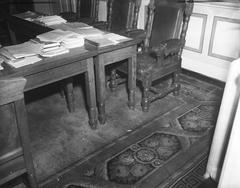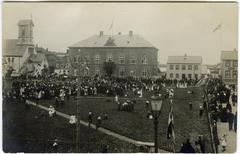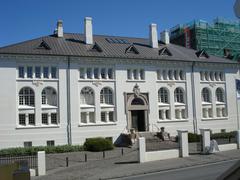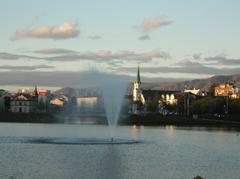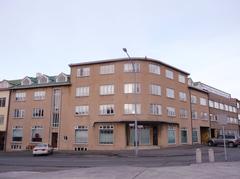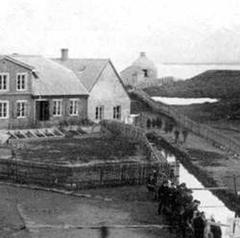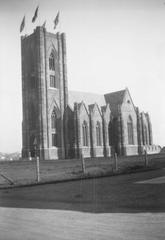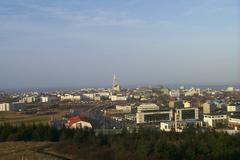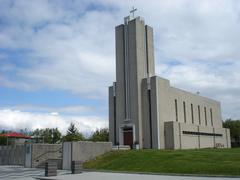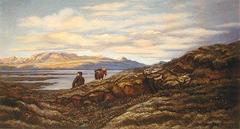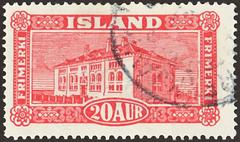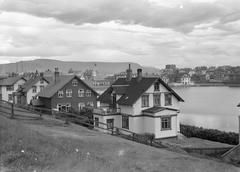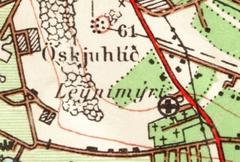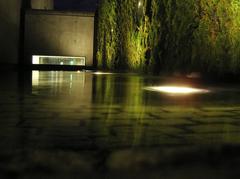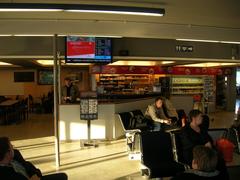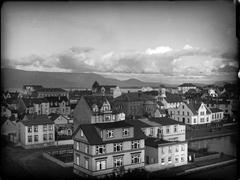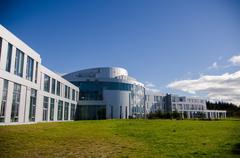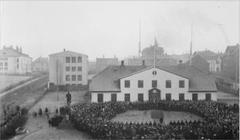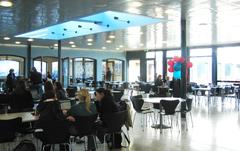Kringlan Reykjavík Iceland: Visiting Hours, Tickets, and Historical Sites Guide
Date: 14/06/2025
Introduction to Kringlan: History and Cultural Significance
Kringlan Mall, located at a major crossroads in Reykjavík, Iceland, stands as a central hub for commerce, culture, and community. Opened in August 1987, Kringlan was Iceland’s first indoor shopping mall, marking a milestone in the city’s modernization and suburban expansion. Over the years, it has grown beyond a retail destination to become an urban center that incorporates modern architectural design, sustainable building practices, and a vibrant calendar of cultural events. The mall’s name, “Kringlan”—meaning “circle” or “ring” in Icelandic—reflects both the surrounding road network and the original architectural vision of connectivity and community.
Kringlan has played a pivotal role in changing consumer habits, encouraging suburban development, and integrating sustainable features such as geothermal heating and energy-efficient lighting. Today, visitors can enjoy a modern shopping environment, diverse dining options, and regular cultural programming, making Kringlan a key destination for both locals and tourists.
For a deeper exploration of Kringlan’s architectural evolution and its role within Reykjavík’s urban landscape, refer to resources such as Kurby Blog and practical travel insights at Joey is a Traveler.
Table of Contents
- Introduction
- Historical Background of Kringlan
- Architectural Evolution
- Visitor Information
- Architectural Highlights
- Nearby Attractions
- Frequently Asked Questions (FAQ)
- Conclusion and Call to Action
- References
Historical Background of Kringlan
Origins and Development
Kringlan’s establishment in 1987 marked Reykjavík’s entry into modern suburban retail. Strategically located and easily accessible, it quickly became a focal point for shopping, socializing, and cultural activities. The mall introduced the concept of a climate-controlled indoor shopping space to Iceland, providing respite from the country’s weather and expanding the retail experience beyond the traditional city center.
Socio-Economic Impact
Before Kringlan, shopping was concentrated along Reykjavík’s core streets, such as Laugavegur. Kringlan’s centralized model not only transformed consumer behavior but also catalyzed further commercial and infrastructure development in the city’s suburbs. The mall’s accessibility by public transport and dedicated cycling routes has strengthened its role as an inclusive community hub.
Architectural Evolution
Initial Design and Expansion
Kringlan’s original architecture featured functional modernist elements: spacious interiors, wide corridors, open atriums, and extensive use of glass for natural light. The exterior combines glass and concrete, in line with Reykjavík’s architectural trends of the late 20th century. With a 50,000 square meter footprint and around 150 outlets, Kringlan quickly became the largest shopping center in Iceland.
Subsequent expansions have added new wings, entertainment venues—including cinemas and theaters—and extensive renovations to improve accessibility and comfort. Sustainability initiatives such as geothermal heating, advanced insulation, LED lighting, and green spaces reflect Kringlan’s commitment to Reykjavík’s eco-friendly goals.
Integration with Urban Life
Kringlan is seamlessly woven into the fabric of Reykjavík through its use of local materials and motifs inspired by Iceland’s volcanic landscapes. The mall supports sustainable mobility with excellent public transport connections, cycling paths, and ample bike and car parking.
Cultural and Social Role
More than just a retail center, Kringlan has become a cultural venue, regularly hosting art exhibitions, concerts, film festivals, and community events. The food court and Kúmen food hall offer a diverse array of culinary experiences, from traditional Icelandic dishes to international cuisine, reflecting the city’s multicultural spirit.
Visitor Information
Opening Hours
- Monday to Friday: 10:00 – 18:30
- Saturday: 11:00 – 18:00
- Sunday: 12:00 – 18:00
Some restaurants and entertainment venues may have different hours. For the latest information, consult Kringlan’s official website.
Entry and Tickets
General entry to Kringlan is free. Tickets are only required for certain entertainment venues, such as cinemas and theater performances, or for special events.
Getting There and Parking
- By Public Transport: Multiple bus lines connect Kringlan to Reykjavík and its suburbs.
- By Bicycle: Dedicated cycling routes and ample bicycle parking support eco-friendly travel.
- By Car: The mall provides extensive free parking.
Accessibility
Kringlan is fully accessible for visitors with disabilities, offering ramps, elevators, accessible restrooms, and designated parking. Family rooms, free Wi-Fi, and ATMs are also available.
Architectural Highlights
- Central Atrium: A light-filled, spacious area with skylights, serving as a gathering point and event space.
- Cultural Spaces: Theaters and exhibition areas that regularly showcase Icelandic art and performances.
- Sustainability Features: Indoor plants, efficient energy systems, and eco-friendly materials throughout the mall.
Nearby Attractions
- Reykjavík City Theatre: Connected to Kringlan, offering a range of performances.
- Hallgrímskirkja Church: Reykjavík’s iconic landmark, less than 2 km away.
- Árbær Open Air Museum: A historical museum showcasing Icelandic life.
- Laugavegur Shopping Street: Reykjavík’s bustling main shopping avenue.
Frequently Asked Questions (FAQ)
Q: What are Kringlan’s opening hours?
A: Monday–Friday 10:00–18:30, Saturday 11:00–18:00, Sunday 12:00–18:00. Some venues may differ.
Q: Is there parking at Kringlan?
A: Yes, there is ample free parking for both cars and bicycles.
Q: Is entry to Kringlan free?
A: Yes, entry is free. Tickets are required only for cinemas, theaters, or special events.
Q: How do I get there by public transport?
A: Multiple bus lines serve Kringlan; cycling and walking routes are also available.
Q: Are there guided tours?
A: Regular guided tours are not common, but cultural events and exhibitions are frequent.
Q: Is Kringlan accessible for visitors with disabilities?
A: Yes, with ramps, elevators, accessible restrooms, and designated parking.
Hallgrímskirkja: Nearby Historical Site
Overview
Hallgrímskirkja is one of Reykjavík’s most recognizable landmarks. Completed in 1986, this Lutheran church features dramatic Expressionist architecture inspired by Iceland’s basalt columns and volcanic scenery. Named for Hallgrímur Pétursson, a celebrated Icelandic poet, the church is both a place of worship and a major cultural attraction.
Location and Access
- Address: Approximately 1.5 miles (2.5 km) from Kringlan, and 0.5 miles (800 m) from the city center.
- Getting There:
- On Foot: 10–15 minutes from the city center via Skólavörðustígur.
- By Bus: Routes 1, 3, and 6 serve stops near Hallgrímskirkja (Straeto).
- By Car: Limited parking available.
Visiting Details
- Opening Hours:
- Summer (June–August): 9:00–21:00
- Spring/Autumn: 9:00–18:00
- Winter (Nov–Feb): 10:00–17:00
- Admission: Free for the main church; tower elevator: ISK 1,000 (discounts available).
- Accessibility: Ramps and elevators for visitors with limited mobility.
- Official Website: hallgrimskirkja.is
Highlights
- Panoramic city views from the tower.
- Expressionist concrete façade inspired by Icelandic geology.
- Renowned pipe organ and serene interior.
- Seasonal concerts and art exhibitions.
Travel Tips
- Best Times to Visit: Weekdays are quieter; weekends offer more events.
- Facilities: Family rooms, ATMs, Wi-Fi, accessible restrooms, and a wide variety of dining options.
- Event Updates: Check Kringlan’s and Hallgrímskirkja’s websites for current schedules and special events.
Conclusion and Call to Action
Kringlan Mall exemplifies Reykjavík’s blend of modernity, sustainability, and cultural vibrancy. As Iceland’s first and largest indoor shopping center, it continues to evolve, offering an inclusive and dynamic environment for shopping, dining, and cultural experiences. With its convenient access, sustainable practices, and ongoing development projects, Kringlan remains an essential part of Reykjavík’s urban landscape.
Plan your visit to Kringlan and explore nearby attractions such as Hallgrímskirkja for a comprehensive Reykjavík experience. For the latest updates, events, and travel tips, consult the official Kringlan website and download the Audiala app for personalized guides and real-time information.
References and Further Reading
- From Past to Present: The Evolution of Reykjavík Iceland’s Architecture – Kurby Blog
- Kringlan Reykjavík: Visiting Hours, Tickets, and Its Cultural Significance – DesignWanted
- First Phase of New Development in the Kringlan Area – Construction.is
- Introducing New Development Plans for the Kringlan Area – Mbl.is
- Visiting Reykjavík Iceland – Joey is a Traveler
- Economic and Housing Construction in Reykjavík – Reykjavik.is
- Straeto Public Transport
